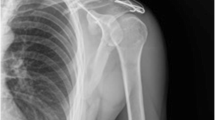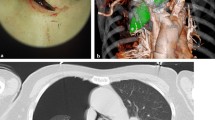Abstract
Purpose
To present a rare case of deep penetrating neck trauma in which a retained foreign body in the cervical spine (a broken knife blade) resulted in delayed radicular injury. We describe the surgical management using a retrojugular approach.
Case report
Our patient sustained a stab wound to the supraclavicular triangle from a small pocketknife. He was initially managed in a local hospital by simple primary wound closure without any radiological examinations, and was discharged home. The patient re-consulted in a delayed fashion with mild local persistent neck pain. Subsequent radiological investigations revealed a foreign body (the broken blade of a pocket knife) embedded in the left neural foramen between the C6 and C7 vertebrae penetrating the disc space. The blade was lying between the left C7 nerve root and the ipsilateral vertebral artery (VA) at the transition of V1 and V2 segments. Initial neurological evaluation was normal. Some days later, the patient developed a delayed left C7 radicular deficit. We undertook urgent exploration along the wound corridor through a retrojugular, transforaminal approach with successful removal of the blade.
Discussion
To our knowledge, this is a unique case where a retained foreign body penetrated the soft tissues of the neck, embedding deep in the vertebral column without vascular, aerodigestive or significant primary neurological injury, while causing delayed neck pain and delayed onset radicular injury. We describe our surgical management for removal of the retained blade. The retrojugular approach gives excellent access to all of the important anatomical structures of the neck from an anterolateral approach.



Similar content being viewed by others
References
Biffl WL, Moore EE, Rehse DH et al (1997) Selective management of penetrating neck trauma based on cervical level of injury. Am J Surg 174:678–682
Kendall JL, Anglin D, Demetriades D (1998) Penetrating neck trauma. Emerg Med Clin North Am 16:85–105. doi:10.1016/S0733-8627(05)70350-3
Shiroff AM, Gale SC, Martin ND et al (2013) Penetrating neck trauma: a review of management strategies and discussion of the “No Zone” approach. Am Surg 79:23–29
Golueke PJ, Goldstein AS, Sclafani SJ et al (1984) Routine versus selective exploration of penetrating neck injuries: a randomized prospective study. J Trauma 24:1010–1014
Bruneau M, Cornelius JF, Marneffe V et al (2006) Anatomical variations of the V2 segment of the vertebral artery. Neurosurgery 59:ONS20–ONS24. doi:10.1227/01.NEU.0000219931.64378.B5 (discussion ONS20–24)
Bruneau M, Cornelius JF, George B (2005) Anterolateral approach to the V2 segment of the vertebral artery. Neurosurgery 57:262–267 (discussion 262–267)
Lot G, George B (1997) Cervical neuromas with extradural components: surgical management in a series of 57 patients. Neurosurgery 41:813–820 (discussion 820–822)
Tisherman SA, Bokhari F, Collier B et al (2008) Clinical practice guideline: penetrating zone II neck trauma. J Trauma Inj Infect Crit Care 64:1392–1405. doi:10.1097/TA.0b013e3181692116
Bell RB, Osborn T, Dierks EJ et al (2007) Management of penetrating neck injuries: a new paradigm for civilian trauma. J Oral Maxillofac Surg Off J Am Assoc Oral Maxillofac Surg 65:691–705. doi:10.1016/j.joms.2006.04.044
Demetriades D, Theodorou D, Cornwell E et al (1997) Evaluation of penetrating injuries of the neck: prospective study of 223 patients. World J Surg 21:41–47 (discussion 47–48)
Gonzalez RP, Falimirski ME (1999) The utility of physical examination in proximity penetrating extremity trauma. Am Surg 65:784–789
Inaba K, Branco BC, Menaker J et al (2012) Evaluation of multidetector computed tomography for penetrating neck injury: a prospective multicenter study. J Trauma Acute Care Surg 72:576–583. doi:10.1097/TA.0b013e31824badf7 (discussion 583–584; quiz 803–804)
Sperry JL, Moore EE, Coimbra R et al (2013) Western Trauma Association critical decisions in trauma: penetrating neck trauma. J Trauma Acute Care Surg 75:936–940. doi:10.1097/TA.0b013e31829e20e3
Fung CF, Ng TH (1992) Delayed myelopathy after a stab wound with a retained intraspinal foreign body: case report. J Trauma 32:539–541
Jones FD, Woosley RE (1981) Delayed myelopathy secondary to retained intraspinal metallic fragment. Case report. J Neurosurg 55:979–982. doi:10.3171/jns.1981.55.6.0979
Kulkarni AV, Bhandari M, Stiver S, Reddy K (2000) Delayed presentation of spinal stab wound: case report and review of the literature. J Emerg Med 18:209–213
Luo Y, Yuan H, Cao ZS (2013) Residual foreign body in the neck after trauma results in the delayed rupture of the common carotid and internal jugular vein: a case report. J Med Case Rep 7:13. doi:10.1186/1752-1947-7-13
Conflict of interest
The authors declare no financial conflict of interest.
Author information
Authors and Affiliations
Corresponding author
Rights and permissions
About this article
Cite this article
Zaldivar-Jolissaint, J.F., Bobinski, L., Van Dommelen, Y. et al. Delayed presentation of deep penetrating trauma to the subaxial cervical spine. Eur Spine J 24 (Suppl 4), 540–543 (2015). https://doi.org/10.1007/s00586-014-3681-4
Received:
Revised:
Accepted:
Published:
Issue Date:
DOI: https://doi.org/10.1007/s00586-014-3681-4




